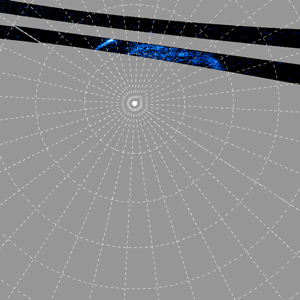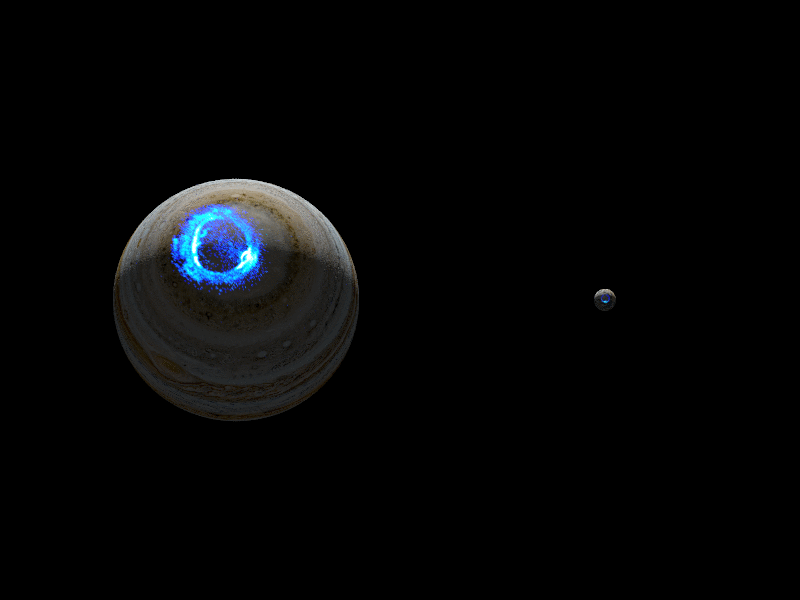A new study tracks the life cycle of the spectacular ultraviolet storms in the big planet’s aurora, generated by charged particles from its volcanic moon, Io
16 March 2021

Evolution of a dawn storm in Jupiter’s polar auroras. This animation was created from observations made by Juno’s UVS (Ultraviolet Spectrograph) instrument. See notes for journalists for access to full sized gif.
Credit: NASA/JPL-Caltech/SwRI/UVS/ULiège/Bonfond
AGU press contact:
Liza Lester, +1 (202) 777-7494, [email protected] (UTC -4:00 hours)
University of Liege press contact:
Julie Louis, +32(0)4/366.99.28, [email protected] (UTC +1:00 hour)
NASA/JPL-Juno press contact:
DC Agle, 818-393-9011, [email protected] (UTC -7:00 hours)
Researcher contact:
Bertrand Bonfond, Chercheur Qualifié FNRS – FNRS Research Associate Space sciences, Technologies & Astrophysics Research (STAR), Institute Université de Liège, Belgium,
+32-(0)4-366-97.72, [email protected] (UTC +1:00 hour)
WASHINGTON—The midnight births of the dramatic bright surges in Jupiter’s aurora known as dawn storms are captured in a new study of data from the Juno space probe.
The storms consist of brightenings and broadenings in the part of the oval of auroral activity that encircles Jupiter’s poles near the edge of dawn. They evolve in a pattern surprisingly reminiscent of familiar surges in the aurora that undulate across Earth’s polar skies, called auroral substorms, according to the authors.
The new study is the first to track the storms from their birth on the nightside of the giant planet through their full evolution. It was published today in AGU Advances, a journal for high-impact, open-access research and commentary across the Earth and space sciences.
During a dawn storm, Jupiter’s quiet and regular auroral arc transforms into a complex and intensely bright auroral feature. It emits hundreds to thousands of Gigawatts of ultraviolet light into space as it rotates from the night side to the dawn side and ultimately to the day side of the planet over the course of 5-10 hours. A Gigawatt is the power produced by a typical modern nuclear reactor. This colossal brightness implies that at least ten times more energy was transferred from the magnetosphere to the upper atmosphere of Jupiter.

The sequence of images shows the evolution of a dawn storm in Jupiter’s polar auroras, from left to right. These observations come from the Juno’s UVS (Ultraviolet Spectrograph) instrument.
Credit: NASA/JPL-Caltech/SwRI/UVS/ULiège/Bonfond
Previously, dawn storms had only been observed from ground-based telescopes on Earth or the Hubble Space Telescope, which can only offer side views of the aurora and cannot see the night side of the planet. Juno revolves around Jupiter every 53 days along a highly elongated orbit that brings it right above the poles every orbit.
“This is a real game changer,” said Bertrand Bonfond, a researcher from the University of Liège and lead author of the new study. “We finally got to find out what was happening on the night side, where the dawn storms are born.”
Familiar auroral sequences, different engines
Polar auroras on Earth and on Jupiter are images of processes occurring in the magnetic fields that surround them. Both planets generate magnetic fields that capture charged particles.
Earth’s magnetosphere is shaped by charged particles flowing out of the sun called the solar wind. Bursts of solar wind stretch Earth’s magnetic field into a long tail on the nightside of the planet. When that tail snaps back, it fires charged particles into the nightside ionosphere, which appear as spectacular auroral light shows.
The new study found the timing of the dawn storms on Jupiter did not correlate with solar wind fluctuations. Jupiter’s magnetosphere is mostly populated by particles escaping from its volcanic moon Io, which then get ionized and trapped around the planet by its magnetic field.
The sources of mass and energy fundamentally differ between these two magnetospheres, leading to auroras that usually look quite different. However, the dawn storms, as unraveled by Juno’s ultraviolet spectrograph, looked familiar to the researchers.

Artistic views of ultraviolet polar auroras on Jupiter (left) and Earth (right, scaled up tenfold), show the similarities between the two kinds of aurora. UV spectrographic data were rendered in 3D software and overlayed on visible images of the planets for clarity.
Credit: NASA/JPL-Caltech/SwRI/UVS/STScI/MODIS/WIC/IMAGE/ULiège/Bonfond
“When we looked at the whole dawn storm sequence, we couldn’t help but notice that the dawn storm auroras at Jupiter are very similar to a type of terrestrial auroras called substorms” said Zhonghua Yao, an author of the new study and scientific collaborator at the University of Liège.
The substorms result from the explosive reconfiguration of the tail of the magnetosphere. On Earth, they are strongly related to the variations of the solar wind and of the orientation of the interplanetary magnetic field. On Jupiter, such explosive reconfigurations are rather related to an overspill of the plasma originating from Io.
These findings demonstrate that, whatever their sources, particles and energy do not always circulate smoothly in planetary magnetospheres. They often accumulate until the magnetospheres collapse and generate substorm-like responses in the planetary aurorae.
“Even if their engine is different, showing for the first time the link between these two very different systems allows us to identify the universal phenomena from the peculiarities specific to each planet,” Bonfond said.
###
AGU (www.agu.org) supports 130,000 enthusiasts to experts worldwide in Earth and space sciences. Through broad and inclusive partnerships, we advance discovery and solution science that accelerate knowledge and create solutions that are ethical, unbiased and respectful of communities and their values. Our programs include serving as a scholarly publisher, convening virtual and in-person events and providing career support. We live our values in everything we do, such as our net zero energy renovated building in Washington, D.C. and our Ethics and Equity Center, which fosters a diverse and inclusive geoscience community to ensure responsible conduct.
Notes for Journalists
This research study is open access. Download a PDF copy of the paper here. Neither the paper nor this press release is under embargo. Download multimedia from AGU’s newsroom sharepoint.
Paper title:
“Are Dawn Storms Jupiter’s auroral substorms?”
Authors:
- Bertrand Bonfond, corresponding author, (Université de Liège)
- Zhonghua Yao (Chinese Academy of Sciences)
- Randy Gladstone (Southwest Research Institute)
- Denis Grodent (University of Liège)
- Jean-Claude Gérard (Université de Liège)
- Jessy Matar (University of Liège)
- Benjamin Palmaerts (LPAP, University of Liege)
- Thomas Greathouse (Southwest Research Institute)
- Vincent Hue (Southwest Research Institute)
- Maarten Versteeg (Southwest Research Institute)
- Joshua Kammer (SWRI)
- Rohini Giles (Southwest Research Institute)
- Chihiro Tao (National Institute of Information and Communications Technology (NICT))
- Marissa Vogt (Boston University)
- Alessandro Mura (INAF-IAPS)
- Alberto Adriani (IAPS-INAF)
- William Kurth (University of Iowa)
- Barry Mauk (Johns Hopkins University)
- Scott Bolton (Southwest Research Institute)